Transcritical CO2 extraction of electrolytes for lithium-ion batteries: optimization of the recycling process and quality–quantity variation
Abstract
Electrolyte solutions have a vital function in lithium-ion batteries. In consideration of their toxic and harmful characteristics and widespread applications in the EVs, the treatment or recovery of the electrolyte is of concern and accurate analysis is needed for the resource and environment benefits. In this work, we present a highly-selective electrolyte recovery method—transcritical CO2 extraction—that combined the extraction and separation processes together. The use of response surface methodology helps in obtaining a simplified and optimized extraction protocol at room temperature and low pressure saving time and reagents. In order to evaluate these extracts, various techniques like GC-MS, GC-FID, FITR and NMR were applied. The GC-FID quantitative analysis and calculation formula may help with realizing the oriented control of the extraction process, and hexafluorophosphate (PF6−), fluoride (F−) and difluorophosphate (PO2F2−) detected by both 19F and 31P spectra imply the degradation pathway.



 Please wait while we load your content...
Please wait while we load your content...